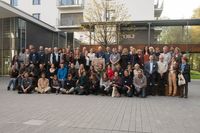The International Common Hamster Workgroup
A short history of the International Common Hamster Workgroup!
The idea to bring together hamster experts was first born during the 1993 conference of the German Society for Mammalian Biology in Tübingen (GER). During this conference it became obvious that the common hamster had been a scientifically neglected species for nearly ten years and in terms of species conservation the urgent need was felt to shed more light on the population decline which, at that time, was a knowledge shared by only a few people.
In January 1994 the first meeting was held at the guest house of the University of Heidelberg. During this initial meeting the dramatic and ongoing decline of Cricetus cricetus in the Netherlands and Germany was discussed and all participants agreed that further actions were needed. Already in October 1994 a second meeting was held in Heidelberg because autumn was considered to be a better time for field biologists who could then present new data from the recent season. The principal aims and purposes of the group, notably to promote hamster research and conservation, to offer an opportunity for exchanging experiences, to support the species protection and to provide advice for administrations, agencies and authorities, have not been changed since then. In the following years the group grew steadily and more countries joined and attended the meetings. The International Common Hamster Workgroup also became an interface for scientists and conservationists, often stimulating new research and conservation strategies.
In the recent years it has turned out that the decline of Cricetus cricetus is not only a problem of the “western range countries” like France, Germany, The Netherlands and Belgium but continues east. Again the International Common Hamster Workgroup has provided a platform for scientists from The Czech Republic, Poland, Russia and Ukraine to present their findings and to get in contact with colleagues concerned with similar problems or research issues.
One of the major outcomes of our group is the recent assessment of the Red List Status for the IUCN (https://www.iucnredlist.org)
Apart from 2008 yearly meetings were held in various countries, organized by volunteers often without or very little financial support. The International Common Hamster Workgroup is not an organized association like the IUCN or WWF or any other NGO. It is a network of scientists and conservationists united in their commitment to protect this species from extinction. As a consequence a vivid exchange of information takes place even beyond the meetings.
The Common Hamster Workgroup meeting 2016 in Heidelberg, Germany
Dates: The meeting will take place in North Rhine Westphalia 11. - 13.10.2024 TBA
Registration : https://beteiligung.nrw.de/portal/lanuv/beteiligung/themen/1008225
